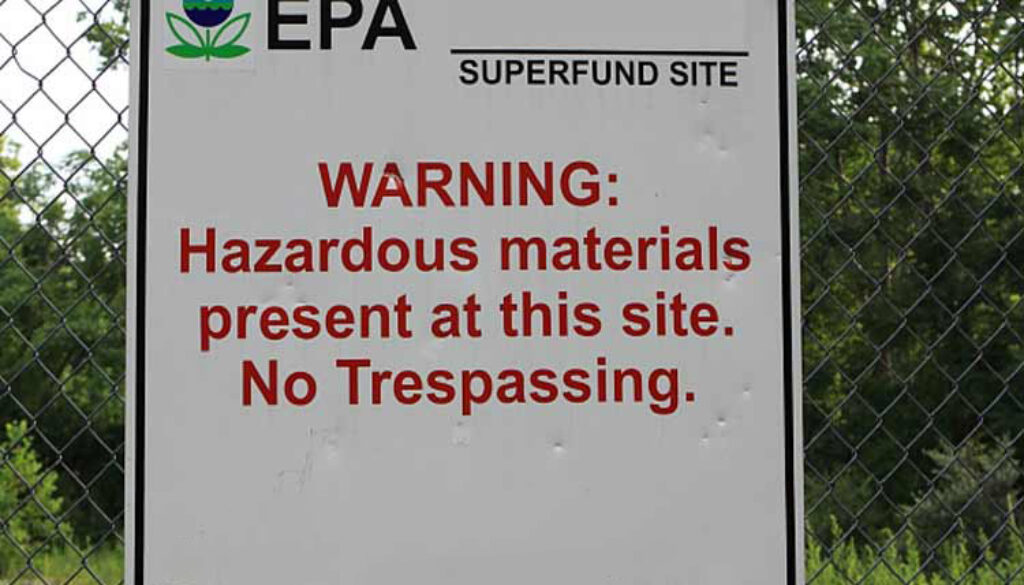“Polluter pays” debate heats up over toxic PFAS chemical cleanup plan
As US regulators work to tackle the toxic threat posed by a class of widely used chemicals known as PFAS, debate is heating up over who could – and should – get hit with the cleanup costs.
Over the last several weeks, federal officials have received an onslaught of conflicting calls for action regarding a proposal to designate certain types of per- and polyfluoroalkyl substances (PFAS) as “hazardous substances” under the nation’s so-called “Superfund” law. The designation would provide a pathway for the remediation of dangerously contaminated sites around the United States, including assigning liability for the hazardous waste cleanup.
The Environmental Protection Agency (EPA) is specifically proposing that PFOA and PFOS and seven other types of PFAS be designated for action under the Superfund law, known formally as the Comprehensive Environmental Response, Compensation, and Liability Act (CERCLA).
The public comment period on the EPA’s proposal ended Friday, drawing fevered pleas from individuals, industries and agencies across the country.
It is the issue of potential liability for PFAS contamination under CERCLA that is sparking fierce debate, as an array of parties, including water providers, landfill operators and even farmers, say they worry they could be saddled with millions of dollars in costs to try to rid their operations of widespread PFAS contamination that they had no hand in creating. They want the EPA and members of Congress to carve out exemptions to protect them.
PFAS are ubiquitous in the environment, used in popular consumer goods as well industrial processes and firefighting foams. A 2022 analysis found detectable levels of PFAS in about 83% of US waterways. They are frequently described as “forever chemicals” because they don’t naturally break down over time. PFAS contamination persists not only in the environment, but also in the bodies of people and animals.
“The specter of the CERCLA designation… is a very real concern for companies in this country,” said environmental lawyer John Gardella, whose practice focuses on PFAS issues. Companies face potentially “enormous financial consequences,” he said.
Multiple bills have been introduced in the US Senate to exempt from liability those “passive receivers” of materials that contain PFAS, such as water treatment plants, airports, fuel depots, and refineries.
But the legislation is raising the ire of environmental health and justice organizations who say exemptions would weaken CERCLA and unfairly benefit industry at the expense of vulnerable communities facing health risks from PFAS contamination.
“The potential for Superfund cleanups gives hope to hundreds of communities impacted by PFAS-polluted land and water,” a group of environmental organizations stated in a joint letter sent to members of Congress. “To exempt any industry… from PFAS liability is unjustified and unwise, could delay cleanups and prolong health risks from PFAS, and could open the door to additional industries demanding exemptions from this bedrock environmental law.”
There is no reason to treat PFAS differently than any other type of hazardous substance under CERCLA, according to Melanie Benesh, a government affairs expert at the Environmental Working Group (EWG), one of the groups signing the letter to Congress. Companies or utilities that have acted responsibly are not targeted for liability under the Superfund framework, and there will be plenty of time to identify and assign responsibility to the true bad actors responsible for PFAS contamination, Benesh said.
“The sky is not falling,” Benesh said. “We’re not going to see a bunch of PFAS sites become Superfund sites overnight.”
“Polluter pays”
PFAS have been linked to many different types of health problems including cancer, birth defects, decreased fertility, and kidney disease. A new study released in July additionally found an association between PFOS and testicular cancer.
The top companies seen bearing responsibility for PFAS pollution are 3M, DuPont de Nemours Inc. and spinoffs Chemours Co. and Corteva Inc. All have agreed to billions of dollars in settlements for PFAS pollution after internal corporate documents, which came to light through litigation, showed company officials were aware decades ago that the PFAS chemicals they were making and using created serious risks to human and environmental health.
Through CERCLA, the US follows a “polluter pays” principle, compelling “potentially responsible parties” to pay for the remediation of designated Superfund sites.
The money 3M and the other companies have agreed to pay out so far for PFAS contamination cleanup is largely aimed at helping public water suppliers ensure drinking water is safe. But the scale of contamination across the environment is so vast that it is unlikely all the costs can be covered by those companies alone, experts say.
The US Chamber of Commerce estimates that private sector cleanup costs at PFOA and PFOS Superfund sites would cost between $700 million and $800 million in annualized costs, with additional public sector spending needed beyond that.
“3M and DuPont can’t pay for it all,” said Rainer Lohmann, co-director of a Superfund research center collaboration created by the University of Rhode Island, Harvard and the Silent Spring Institute. “This is just the reality. Polluter pays is a fantastic principle and I wish we were able to make it work. It’s very difficult once you have such widespread use and contamination. There is not enough money to cover all the costs.”
Some states are already discussing ways to establish funds for PFAS remediation efforts or zero interest loan programs that companies can tap into for such remediation efforts.
“Of course, the federal government has set aside some money already for PFAS issues, but it is likely that increasing pressure will be put on elected officials at the federal level to set aside even greater amounts of money for PFAS remediation issues,” said Gardella.
Opposing views
Opposition to the EPA effort to designate certain PFAS as hazardous substances runs the gamut, from public water utilities in California to farmers and ranchers across the US Midwest, where fields are often spread with treated sewage as fertilizer that may be contaminated with PFAS. PFAS chemicals also can also be found in water provided to livestock and crops, leading to the presence of PFAS in milk, meat, and other foods.
In a letter to the EPA filed Aug. 9, a public water agency in Southern California said the government should focus on eliminating PFAS in consumer products and not on regulating PFAS as hazardous substances under CERCLA due to “cost and liability concerns.”
In separate comments, the Association of California Water Agencies (ACWA) told the EPA that all its members have “serious concerns with the potential unintended consequences” of the PFAS designation.
A regional wastewater treatment provider serving southeast Virginia weighed in with the EPA last week, writing in its comment: “Successful reduction of this exposure depends upon significantly reducing the amount of PFAS that enters commerce, particularly the non-essential uses. For those PFAS that are already in the environment and pose a potential clean-up burden, it is essential that communities do not bear the costs of clean-up.”
In contrast to the comments from industry that focused on financial issues, multiple comments were submitted to the EPA from private individuals, most pleading for protections from PFAS pollution.
“We need to eliminate them right now, and hold individuals and companies accountable for their use and dispersion,” Linda Nelson Keane, an art professor from Chicago, told the EPA in an Aug. 8 letter. Calling PFAS an “offense to our health,” she wrote: “Life on earth needs clean air, water, and energy. If we know something is bad we must stop its use.”
Among the comments from individuals were expressions of outrage that the costs of cleaning up PFAS contamination might outweigh the benefits to citizens, including one stating the “life of many innocent families… should be held as more important than money….”
Another stated: “It is time we stop letting corporations do what is best for profits and time to start doing what is best for our people.”
 EWG
EWG



August 13, 2023 @ 6:35 pm
One can already see the corporate manipulations coming… the spinoff that’s saddled with the ‘blame’ for the economically poisonous attribute and then becoming the sacrificial goat that protects the actual guilty party. The phoney part of “corporate personhood” is that they can simply vanish & reappear moments later with a new name but the same old management & ownership… ready to be ‘reborn’.
The legal percs that current laws offer to out-of-control capitalists are beyond “distressing”. They’re going to ultimately destroy our fledgling attempt at ‘democracy’, in favour of those old tried-&-true systems: kings, authoritarians, autocrats, & something like “corporate feudalism”. That’s where these kinds of confrontations with BIG $$ will take us. ^..^